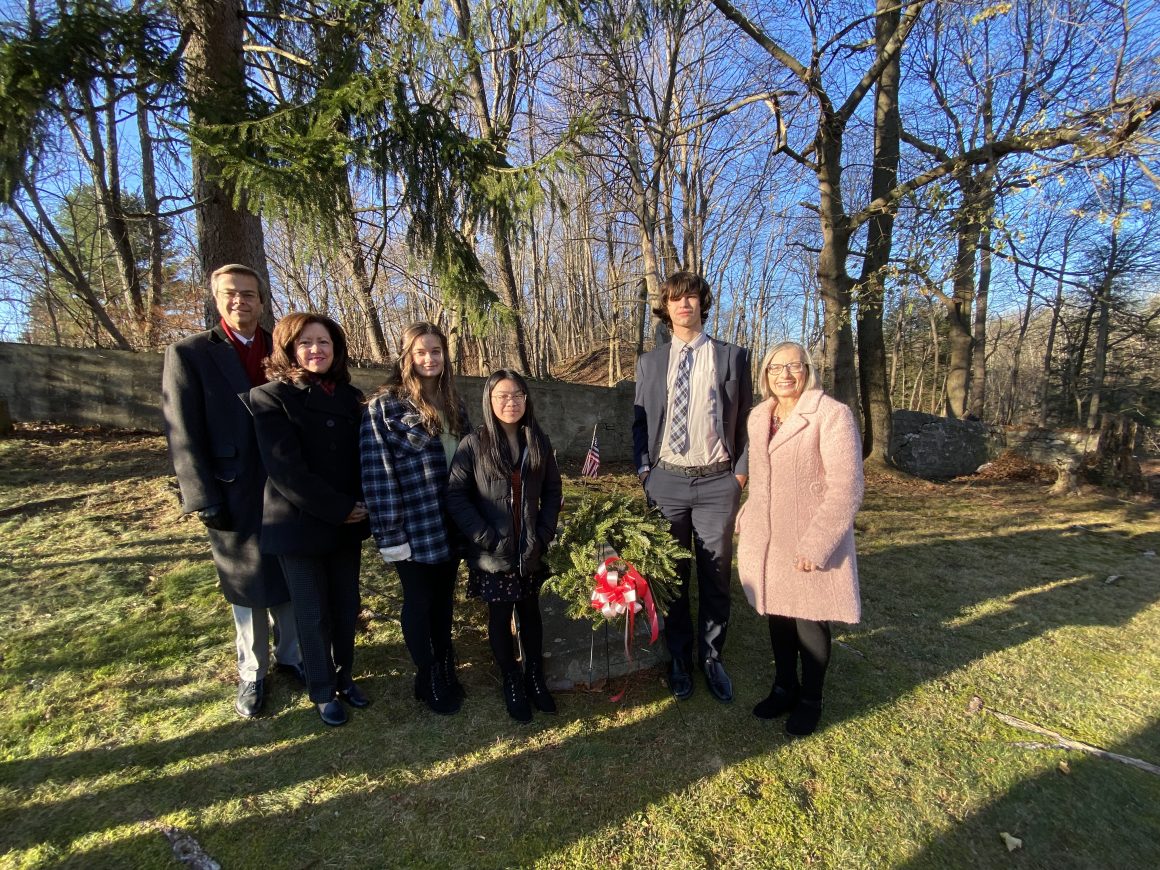Senior class officers laid a wreath on the Coxes’ grave at St. James Church on Tuesday morning and Donna Titus, MMI English Department Chair and longest tenured faculty member at MMI, provided a few words at the site. The class then toured the historic Coxe home and enjoyed refreshments. Upon return to the School, they worked with the underclassmen to provide the history of the School’s founders with a Kahoot! Trivia game and Scavenger Hunt.
MMI also welcomed back young alumni from the last five graduating years to visit with faculty, staff, and students. MMI Head of School Theresa Long said, “We have such a rich and memorable history. The honoring of Eckley and Sophia Coxe provides students the opportunity to engage in that history and learn how our school came to be and why we have so much to be thankful for now and for the future.”
The lives of Eckley and Sophia Coxe provide an interesting history of the early coal-mining days and history of the Hazleton area. Upon Eckley Coxe’s death from pneumonia on the morning of May 13, 1895, The New York Times extolled Coxe as a man of high moral character who refused even the appearance of impropriety, one of the largest individual coal operators in the country, and a friend to many throughout the region who mourned his passing, including the employees who labored in his mines.
Coxe was born June 4, 1839, in Philadelphia and came from a large and distinguished family that had been in the United States since before the American Revolution. His grandfather, Tench Coxe, was an economist and publicist as well as an assistant to Thomas Jefferson in the Treasury Department. He bought land in several Pennsylvania counties, mainly Luzerne, which contained large deposits of coal. The lands were expanded by his son, Charles S. Coxe, who was, at one time, a judge in the District Court of Philadelphia.
At the age of 16, Eckley showed signs of engineering and mechanical ability and entered the University of Pennsylvania in Philadelphia. Hoping to become a mining engineer, he studied chemistry and physics at the University; however, he learned the basics of mining by spending time in his family’s coalfields.
After graduating from Penn in 1858, Eckley was sent abroad to continue his studies at the Ecole des Mines in Paris, France. He attended the Mining Academy in Freiberg in Saxony, where he studied mechanics, which piqued his interest in mechanical inventions that aided the mining industry. After returning to the United States in 1864, he put his training to work. The following year, he established Coxe Brothers & Co. to combine control of the coal lands. Soon, his firm controlled more than 35,000 acres of coalfields and increased coal production. This consolidation brought almost every mining operation in northeastern Pennsylvania under his control and is considered to be one of Eckley’s greatest accomplishments.
A large measure of Eckley’s success came from his generous and well-executed management of labor. He believed in treating his employees as equals and proved to them in many ways that his friendship was sincere.
Coxe was also considered to be a strong force in public affairs and was elected to the Senate as a Democrat in 1880. However, upon finding the oath of office required him to swear he did not use his money to win, Coxe refused the position because of a contribution he had given to his party committee. He was re-nominated and re-elected without spending any money, but he had little taste for a political career and felt he was needed elsewhere.
His interest turned to the technical education being given to young people. His concern produced the Mining and Mechanical Institute – today’s MMI Preparatory School. This institution, founded in 1879, was chartered in 1894 as an all-boys’ school to teach the sons of miners. Today, it is a co-educational college preparatory school serving students in grades six through 12.
Coxe also took an interest in Lehigh University’s engineering school and served as one of its trustees. He excelled in other fields, as well. He built the first steel coal breaker, invented the Coxe traveling grate (which is used in boilers), established machine shops, and even constructed his own railroad.
Eckley was always ready to help a worthy cause and was regarded by the captains of industry as a shining example of all that was upright and honorable.
When Eckley Coxe passed away in 1895, it was his wish to be buried in the churchyard of St. James Episcopal Church, Drifton, near the site of a social center he had built for his employees.
His wife, Sophia Georgianna (Fisher) Coxe, was equally well known throughout the region. Because of all the charitable works she performed throughout her lifetime, she was known as the “Angel of the Anthracite.”
The daughter of Joshua and Elizabeth Fisher, Sophia was part of Philadelphia’s upper class. In fact, Sophia’s grandfather signed the Declaration of Independence, while many of her ancestors played prominent roles in the American Revolution.
When Sophia married Eckley B. Coxe in 1869, she moved from the luxurious lifestyle she had always known to the unfamiliar coal fields of Drifton, a town of rugged miners who worked long, hard hours to support themselves and their families. She made a new life for herself by conducting community service activities and focusing her attention on her new hometown and its people. Sophia distributed food and medicine to needy miners and their families.
Her love of people and concern for their welfare prompted her to establish a hospital in Drifton, the first one in the area. Sophia also helped found St. James Episcopal Church in 1884 and taught Sunday school at the church for 40 years.
Christmas was the most celebrated event for the Coxe family. Even though Eckley and Sophia had no children, she traveled each year to New York City, where she personally selected dolls, sleds, and other toys for the children of the village.
Sophia always focused her attention on how she could better life in the community. She gave a large donation to the newly established Hazleton State Hospital and helped institutions and organizations dealing with blind and crippled children. She employed a staff of nurses to visit the miners’ homes in Drifton.
Upon her husband’s death, Sophia was given his entire income; however, she spent only 10 percent on necessities for herself and donated the rest to charity.
In memory of her husband, Sophia Coxe built and equipped the Eckley B. Coxe Memorial Mining Laboratory at Lehigh University, Bethlehem. She also provided a building for MMI – the School’s former gymnasium.
On November 26, 1925, Sophia celebrated her 85th birthday and Thanksgiving as she made her last public appearance. Even though she was in ill health and her physicians advised against attending, she was determined to dedicate her newest accomplishment, the new MMI gymnasium.
Sophia Coxe died four months later on March 3, 1926. She is buried beside her husband in the churchyard of St. James Episcopal Church.

